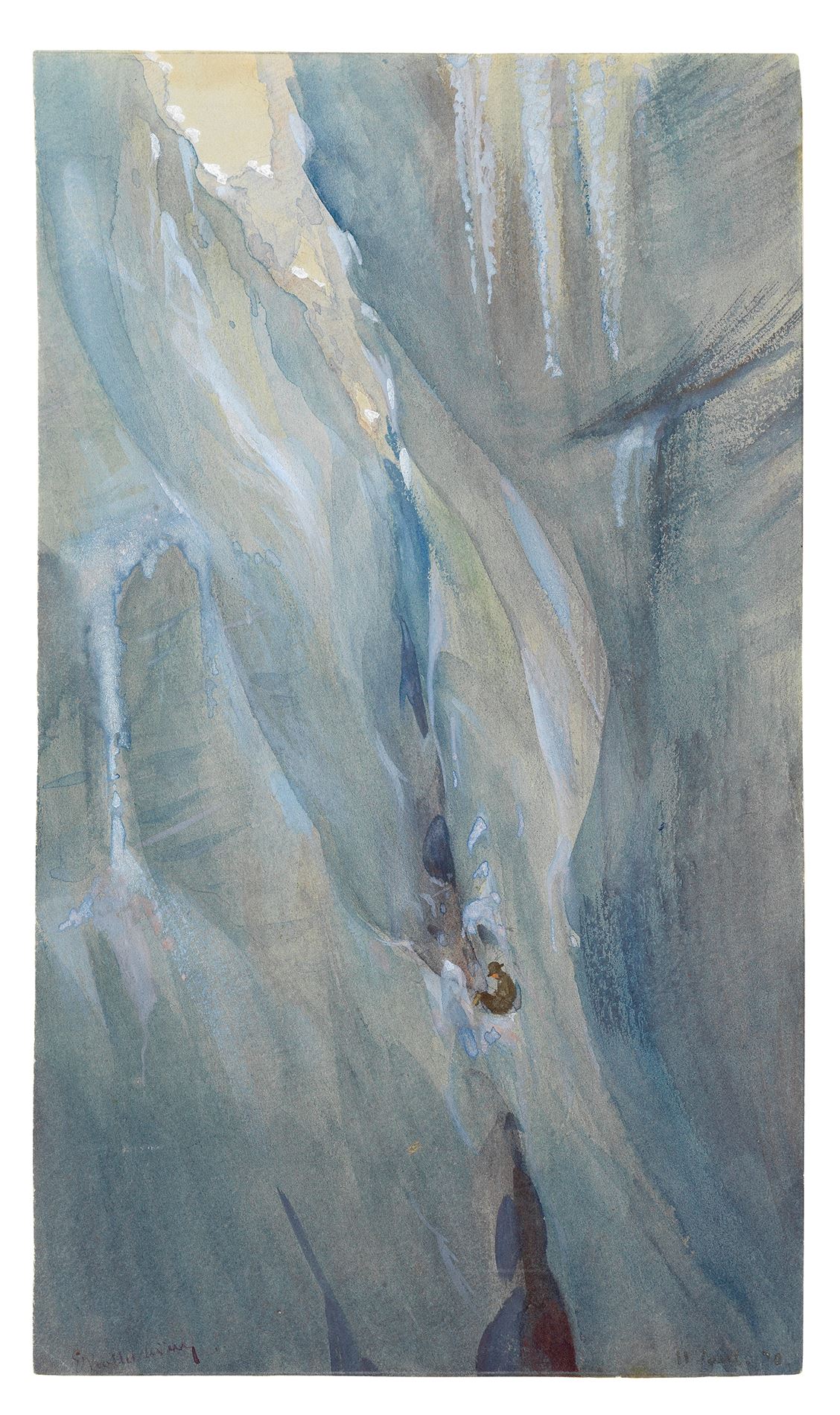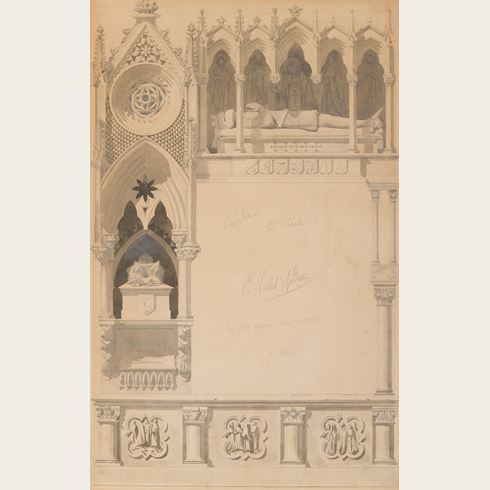Eugène Emmanuel VIOLLET-LE-DUC
(Paris 1814 - Lausanne 1879)
The Artist Sketching While Trapped in a Crevasse
Sold
Watercolour heightened with gouache.
Signed E Viollet le Duc at the lower left and indistinctly dated 11 juill. 70 at the lower right.
229 x 133 mm. (9 x 5 1/4 in.)
Signed E Viollet le Duc at the lower left and indistinctly dated 11 juill. 70 at the lower right.
229 x 133 mm. (9 x 5 1/4 in.)
Viollet-le-Duc had a lifelong interest in the mountains and glaciers of the French and Swiss Alps. Beginning in 1868, and in particular between 1871 and 1876, he spent many weeks climbing and hiking on the Mont Blanc massif. As has been noted of the artist, ‘mountaineering counted among his greatest pleasures, a form of physical and mental exercise that grew compulsive by the late 1870s. Above all, he took refuge in the mountains to liberate himself from the claustrophobic Parisian scene.’ Viollet-le-Duc’s studies of alpine topography and geology culminated in the publication in 1876 of his magisterial book, Le massif de Mont Blanc. He was also a highly accomplished painter of mountain scenes and produced numerous drawings and watercolours of alpine subjects. In his book Histoire d’un dessinateur, published in 1879, he devoted an entire chapter to a description of a sketching tour in the Alps, with a detailed description of rock formations, ice and snow.
This fascinating watercolour, which is dated ‘11 juill. 70’, would appear to record an accident that befell Viollet-le-Duc on that day, while on the Schwartzberg glacier in the canton of Valais in Switzerland, part of the Mont Blanc massif. On the morning of the 11th of July 1870, he was on a trek, accompanied by a guide, when he suddenly fell into a deep glacial crevasse. As he recalled, in an account of the incident published eight years later, ‘“Crevasse de fond”, I said to myself in the second that followed the collapse of the crust of snow, “I am lost!”. Indeed, in this brief space of time, seeing only the blue wall of ice, I could tell that I was falling into one of those transversal glacial crevices that run all the way down to the valley line or thereabout.’
Fortunately, his fall was broken by a rope with which he was attached to his guide, Baptiste, and the artist found himself dangling in mid-air two or three metres below the mouth of the crevasse: ‘The place where I was suspended was admirably beautiful; smooth walls of ice, azure and green. I was in a sepulchre of aquamarine and sapphire whose sides plunged toward an unfathomable depth of deep blue, and then black. My first impression was that I could not have chosen a more splendid tomb. My guide was not saying a word; I just sensed the efforts he was making to bring me back to the mouth of the crevice. ‘Eh?”, I said to him, “I am a dead man!”.’
As Baptiste’s attempt to haul the artist back to the surface were proving ineffectual, Viollet-le-Duc decided to cut the rope to free the guide, who would likely freeze to death otherwise: ‘I pull out my knife and shouted: “I am cutting the rope!”...and then I fell into the abyss along the smooth wall of the crevice. How is it possible that instead of falling vertically to the bottom of this admirable sepulchre, following the law of gravity, I obliquely slid upon a slightly undulated ice surface? I do not know. The fact is that, at a depth of approximately twelve meters, I was extremely surprised to find myself sitting legs up, American style, on a piece of ice held, thanks to a narrowing of the crevice, at approximately five metres to the left of the point I was before.’4 The artist remained in this position deep within the crevasse for three and a half hours, before Baptiste was able to return from the village of Mattmark with four strong men and a length of rope, and pull him to safety. As Martin Bressani notes, however, Viollet-le-Duc ‘had put to good use the time spent in the bosom of the glacier, calmly making a series of drawn observations on the phenomena of the regelation and exudation of the glacier mass that he later consigned in a separate chapter of Le massif du Mont Blanc.’
Among stylistically comparable works by Viollet-le-Duc are two watercolour and gouache drawings of Above the Grands-Mulets and An Avalanche, both of 1869, in the collection of the Musée Lambinet in Versailles. Other, similar watercolours of alpine subjects include views of The Tré-la-Tête Glacier, in the collection of the Médiathèque de l’architecture et du patrimoine in Charenton-le-Pont, and an unidentifed alpine view, dated September 1879, in the Viollet-le-Duc archives in Neuilly.
This fascinating watercolour, which is dated ‘11 juill. 70’, would appear to record an accident that befell Viollet-le-Duc on that day, while on the Schwartzberg glacier in the canton of Valais in Switzerland, part of the Mont Blanc massif. On the morning of the 11th of July 1870, he was on a trek, accompanied by a guide, when he suddenly fell into a deep glacial crevasse. As he recalled, in an account of the incident published eight years later, ‘“Crevasse de fond”, I said to myself in the second that followed the collapse of the crust of snow, “I am lost!”. Indeed, in this brief space of time, seeing only the blue wall of ice, I could tell that I was falling into one of those transversal glacial crevices that run all the way down to the valley line or thereabout.’
Fortunately, his fall was broken by a rope with which he was attached to his guide, Baptiste, and the artist found himself dangling in mid-air two or three metres below the mouth of the crevasse: ‘The place where I was suspended was admirably beautiful; smooth walls of ice, azure and green. I was in a sepulchre of aquamarine and sapphire whose sides plunged toward an unfathomable depth of deep blue, and then black. My first impression was that I could not have chosen a more splendid tomb. My guide was not saying a word; I just sensed the efforts he was making to bring me back to the mouth of the crevice. ‘Eh?”, I said to him, “I am a dead man!”.’
As Baptiste’s attempt to haul the artist back to the surface were proving ineffectual, Viollet-le-Duc decided to cut the rope to free the guide, who would likely freeze to death otherwise: ‘I pull out my knife and shouted: “I am cutting the rope!”...and then I fell into the abyss along the smooth wall of the crevice. How is it possible that instead of falling vertically to the bottom of this admirable sepulchre, following the law of gravity, I obliquely slid upon a slightly undulated ice surface? I do not know. The fact is that, at a depth of approximately twelve meters, I was extremely surprised to find myself sitting legs up, American style, on a piece of ice held, thanks to a narrowing of the crevice, at approximately five metres to the left of the point I was before.’4 The artist remained in this position deep within the crevasse for three and a half hours, before Baptiste was able to return from the village of Mattmark with four strong men and a length of rope, and pull him to safety. As Martin Bressani notes, however, Viollet-le-Duc ‘had put to good use the time spent in the bosom of the glacier, calmly making a series of drawn observations on the phenomena of the regelation and exudation of the glacier mass that he later consigned in a separate chapter of Le massif du Mont Blanc.’
Among stylistically comparable works by Viollet-le-Duc are two watercolour and gouache drawings of Above the Grands-Mulets and An Avalanche, both of 1869, in the collection of the Musée Lambinet in Versailles. Other, similar watercolours of alpine subjects include views of The Tré-la-Tête Glacier, in the collection of the Médiathèque de l’architecture et du patrimoine in Charenton-le-Pont, and an unidentifed alpine view, dated September 1879, in the Viollet-le-Duc archives in Neuilly.
An architect and restorer of medieval buildings, as well as a painter, watercolourist and illustrator, Eugène Viollet-le-Duc is best known for his reconstruction and renovation of Gothic buildings and churches throughout France. Although he decided at an early age to become an architect, he chose not to follow the usual path of studying at the Ecole des Beaux-Arts in Paris, preferring instead to apprentice with the architects Jean-Jacques-Marie Huvé and François-René Leclère. He also travelled extensively around France, visiting the Auvergne, Provence, Normandy, the Pyrenées and Languedoc, as well spending several months in Italy. He taught at the Ecole de Dessin in Paris, and between 1837 and 1844 contributed some 250 illustrations for Baron Taylor, Charles Nodier and Alphonse de Cailleux’s monumental Voyages pittoresques et romantiques dans l’ancienne France, published in twenty-four volumes between 1820 and 1878.
In 1838 Viollet-le-Duc began working for the Conseil des Bâtiments Civils, which supervised work on buildings belonging to the State, and in particular the restoration of national monuments. Through the intervention of Prosper Merimée at the Commission des Monuments Historiques, he was commissioned to take charge of the restoration of the Romanesque abbey of Sainte-Marie-Madeleine at Vézelay in 1840. This was the first of several major renovation projects that Viollet-le-Duc was closely involved in, among the most significant being the restoration of Sainte-Chapelle and Notre-Dame in Paris, the abbey of Saint-Denis and the cathedrals of Amiens, Reims and Clermont-Ferrand, as well as the walls of Carcassonne and Avignon.
Viollet-le-Duc’s close study of Gothic architecture led to an interest in stained glass production, and between 1840 and 1847 he provided designs for stained glass windows for the Sèvres porcelain factory, while also designing liturgical objects and furnishings in a Gothic Revival style for many of the churches where he worked. He was perhaps equally as important as a theorist, and his writings had a significant impact on the understanding and appreciation of medieval architecture, and were an influence on the 19th century practice of architectural restoration. Much of his subsequent fame also rests on his seminal Dictionnaire raisonné de l’architecture française du XIe au XVIe siècle, published in ten volumes between 1854 and 1868 and a highly influential work among such later architects as Antoni Gaudí and Victor Horta.
Other important studies authored by Viollet-le-Duc include a comprehensive study of medieval and Renaissance furniture, jewellery, armour, clothing, musical instruments and interior decoration in France, published between 1858 and 1875 as the Dictionnaire raisonné du mobilier français de l’epoque carolingienne à la renaissance, and the two-volume Entretiens sur l’architecture, which appeared between 1863 and 1872. An outstanding draughtsman, Viollet-le-Duc’s remarkable watercolours of buildings and interiors are some of the most beautiful examples of architectural draughtsmanship of the 19th century.
During the Second Empire Viollet-le-Duc worked extensively for the Emperor Napoleon III, decorating the interior of Notre-Dame for the baptism of the Prince Imperial in 1856 and designing a monument to Napoleon I in his birthplace of Ajaccio in Corsica, completed in 1865, as well as restoring the château of Pierrefonds in the Oise. He also designed a number of private homes in Paris, as well as several châteaux and three churches. The architect lived through the Siege of Paris - which he recorded in several drawings - during the Franco-Prussian war of 1870-1871, and the defeat of France and the events of the Paris Commune affected him greatly. An outstanding draughtsman, Viollet-le-Duc’s remarkable watercolours of buildings and interiors are some of the most beautiful examples of architectural draughtsmanship of the 19th century.
Provenance
Galerie du Luxembourg, Paris.
Literature
Stephanie Buck and Anita Viola Sganzerla, ed., Connecting Worlds: Artists and Travel, exhibition catalogue, Dresden, 2023, p.4, p.65, pp.98-99, no.23.
Exhibition
Dresden, Staatliche Kunstsammlungem, Kupferstich-Kabinett, Connecting Worlds: Artists and Travel, 2023, no.23.






